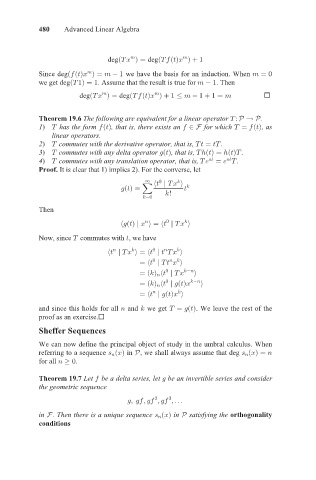Page 496 - Advanced Linear Algebra
P. 496
480 Advanced Linear Algebra
deg²;% ³ ~ deg²; ²!³% ³ b
Since deg² ²!³% ³ ~ c we have the basis for an induction. When ~
we get deg²; ³ ~ . Assume that the result is true for c . Then
deg²;% ³ ~ deg²; ²!³% ³ b c b ~
Theorem 19.6 The following are equivalent for a linear operator ;¢ F ¦ F .
)
1 ; has the form ²!³ , that is, there exists an < for which ; ~ ²!³ , as
linear operators.
2 ; ) commutes with the derivative operator, that is, ! ; ~ ! ; .
)
3 ; commutes with any delta operator ²!³ , that is, ; ²!³ ~ ²!³; .
4 ; ) commutes with any translation operator, that is, ; ! ~ ! ; .
)
Proof. It is clear that 1 implies 2 . For the converse, let
)
B º! ;% »
²!³ ~ !
!
~
Then
º ²!³ % » ~ º! ;% »
Now, since commutes with , we have
!
;
º! ;%» ~ º! ! ;%»
~º! ;! % »
~² ³ º! ;% c »
~ ² ³ º! ²!³% c »
~º! ²!³% »
and since this holds for all and we get ; ~ ² ! ³ . We leave the rest of the
proof as an exercise.
Sheffer Sequences
We can now define the principal object of study in the umbral calculus. When
F
referring to a sequence ²%³ in , we shall always assume that deg ²%³ ~
for all .
Theorem 19.7 Let be a delta series, let be an invertible series and consider
the geometric sequence
Á Á Á Á Ã
<
F
in . Then there is a unique sequence ²%³ in satisfying the orthogonality
conditions

